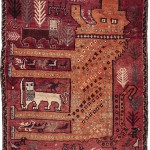Antique Qashqa’i Lion Rug
Lion rugs are a group of Persian rugs with the image of the lion as the main motif. These have been known to Iranians since at least the 12th century. The oldest dated lion rug, however, goes back to 1211 A.H. (1796 A.D.) (Tanavoli, 1985, p. 44, pl. 1). This rug was made for a khan (tribal chieftain). It is possible that many of the existing lion rugs were made for khans, as there is an old tradition of spreading lion rugs in royal courts. The khans followed that tradition and spread lion rugs in their tents as a sign of power.The lion has been a symbol of royalty and power since the second millennium BCE. An Elamite sculpture now in Louvre Museum shows Queen Narundi on a throne supported by two lions (Tanavoli, 1985, p. 19, fig. 20). The lion was also an important symbolic element in royal palaces. In both Susa and Persepolis, under the later Achaemenids (ca. 460-330 BCE), stone capitals of columns took the form of lions. To show their royal power, Sasanian kings were portrayed fighting and hunting lions (see Tanavoli, 1985, p. 12, fig. 6, and p. 20, fig. 22).These customs were taken up again in Islamic Iran. In the 17th-century Chehel Sotun Palace, Isfahan, stone column bases were made in the form of lions. In the 19th century, the Qajar kings used the image of the lion as column bases in the Golestān Palace, Tehran, and on some of their thrones, such as the Marble Throne in the Golestān Palace and the Throne of Nāder Shah (r. 1736-47), in the former Royal Jewel Collection, Tehran. A rock relief carved at Ray (south of Tehran) shows Fatḥ-ʿAli Shah (r. 1797-1834) mounted on a horse and hunting a lion. The relief was carved over a Sasanian rock relief with the same subject (Tanavoli, 1985, p. 20).Stone grave markers in the form of lions guard the tombs of Shiʿite warriors and martyrs from the 17th century onward in the same areas where lion rugs have been made, and the designs of these objects are related to those of the textile depictions. Lion rugs were first collected and introduced by Parviz Tanavoli and exhibited in the United States in 1974 (see Tanavoli, 1974). Since then, they have been displayed in various museums in Australia, Canada, Europe, and Iran. The collection consists of sixty lion rugs of different shapes, compositions, and subject matters, among them lions with and without manes, lions as the king of beasts, ferocious lions, lions inspired by the stone lions, tiger-like and leopard-like lions, the lion-and-sun motif, lion in the hunting ground, lion and lioness, and families and groups of lions. Each of these types is inspired by different sources, such as tombstone lions, the former lion-and-sun emblem on the Iranian flag, lions on coins, etc. (Tanavoli, 1985, pp. 49-54).Many weavers of lion rugs drew only on their imagination. Their creators (most often women) never saw any lion, whether in life or an image. Thus there are lions depicted in rugs in red, green, and black, and with unusual shapes, many of them with expressions reminiscent of human faces.Bibliography: Parviz Tanavoli, Lion Rugs from Fars, Washington D.C., 1974.
Parviz Tanavoli, Lion Rugs: The Lion in the Art and Culture of Iran, Basel, 1985.
